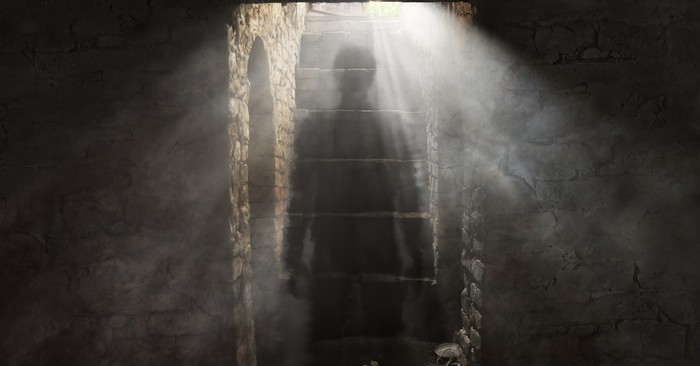
But one of the most difficult things for unbelievers to grapple with is the account of the resurrection of Jesus Christ found in the Gospels. Claiming a man came back to life after a torturous death and three days in a grave is enough for many to simply walk away without hearing anything more. However, the fact of the resurrection is a cornerstone of our faith.
“I am the Living One; I was dead, and now look, I am alive for ever and ever! And I hold the keys of death and Hades” (Revelation 1:18).
Contrary to many skeptics’ opinion, the Bible is not simply a collection of ancient religious documents, filled with mythology and fantastic stories. Over the last century, especially, archeology and historical studies have proven the facts of many of the people, places and things discussed in Scripture. The discipline of Christian Apologetics (learning to defend the faith using facts and logical argument) has grown and gets stronger and more important every year.
But one of the most difficult things for unbelievers to grapple with is the account of the resurrection of Jesus Christ found in the Gospels. Claiming a man came back to life after a torturous death and three days in a grave is enough for many to simply walk away without hearing anything more. However, the fact of the resurrection is a cornerstone of our faith.
“… if you confess with your mouth the Lord Jesus and believe in your heart that God has raised Him from the dead, you will be saved” (Romans 10:9).
The truth about the resurrection and what a person believes has eternal consequences. If the facts are true, the resurrection of Jesus Christ is a life-altering, paradigm-shifting event to anyone and everyone who believes. If it’s not true, it is the biggest hoax in history.
For those who take time to consider the facts surrounding the resurrection, they will discover that the gospel account is recorded in such a way that it is clearly historically reliable. There are so many archeological facts and contemporary historical documents now available that a budding Christian Apologist can study, that books have been written for those wanting a deeper dive. But everyone should know at least a few of the most compelling facts of the resurrection to get you through your next family holiday dinner!
Mary’s Eye-Witness Testimony
“Now the first day of the week Mary Magdalene went to the tomb early, while it was still dark, and saw that the stone had been taken away from the tomb. Then she ran and came to Simon Peter, and to the other disciple, whom Jesus loved, and said to them, ‘They have taken away the Lord out of the tomb, and we do not know where they have laid Him’” (John 20:1-3).
Mary arrived at the tomb while it was still dark and found that the massive stone cover had already been rolled away. But what does that have to do with the reliability of the resurrection account?
A second-century, anti-Christian Greek philosopher named Celsus said of Mary Magdalene: “How can anyone expect rational men to listen to the testimony of a hysterical female?”
We can all recognize that the Bible was written during an historical period of time which was clearly misogynistic. In that culture and time, if you, as a historian, wanted to be considered reliable, the last person you would choose as your primary eye-witness would be a woman. In fact, this became an Achilles heel impeding the work of early Christian evangelists. So, a person trying to create a hoax to deceive people about the resurrection would never use a woman to assert the truth of the facts surrounding a matter.
Therefore, the only plausible explanation of why women were credited as eye-witnesses in the official record, is because the facts of the event were recorded just as they actually happened.
Moreover, this eye-witness was not just any woman, this was Mary Magdalene! According to Luke 8, Mary Magdalene was a woman who had seven demons, and Jesus delivered and set her free. As a full-blown demoniac, it is likely she had been demonstrably crazy: a person who ran around half-naked, talked to themselves, heard voices, smelled, cried out in public, lived homeless and was avoided by the entire village.
And this is the person whom Jesus hand-selected to be first witness to His resurrection and to become His messenger to the other disciples:
“But Mary stood outside by the tomb weeping, and as she wept, she stooped down and looked into the tomb. And she saw two angels in white sitting, one at the head and the other at the feet, where the body of Jesus had lain. Then they said to her, ‘Woman, why are you weeping?’ She said to them, ‘Because they have taken away my Lord, and I do not know where they have laid Him.’ Now when she had said this, she turned around and saw Jesus standing there, and did not know that it was Jesus. Jesus said to her, ‘Woman, why are you weeping? Whom are you seeking?’ She, supposing Him to be the gardener, said to Him, ‘Sir, if You have carried Him away, tell me where You have laid Him, and I will take Him away.’ Jesus said to her, ‘Mary!’ She turned and said to Him, ‘Rabboni!’ (which is to say, Teacher). Jesus said to her, ‘Do not cling to Me, for I have not yet ascended to My Father; but go to My brethren and say to them, ‘I am ascending to My Father and your Father, and to My God and your God.’ Mary Magdalene came and told the disciples that she had seen the Lord, and that He had spoken these things to her” (John 20:11-18).
Why? Because it’s such a crazy scenario for that time and place, it has to be reliable! And what’s more, it demonstrates that the Gospel is salvation for even the worst of humanity. It proves how Jesus Christ saves: not by works, but by His grace!
So from a cultural point of view, the presence of Mary in the narrative is proof positive of the reliability of the facts surrounding the resurrection. However initially, Mary couldn’t see who He was because the pain of the crucifixion was standing in the way. Despite her crisis of faith, Jesus made Himself known to her – He’s that good. And we can be certain that Jesus will also make Himself known to anyone who honestly seeks to examine the truth of the Resurrection.
Peter and John’s Eye-Witness Testimony
“Peter therefore went out, and the other disciple, and were going to the tomb. So they both ran together, and the other disciple outran Peter and came to the tomb first” (John 20:4).
I love how, in the midst of the all the amazing details of the resurrection narrative, John’s human competitive edge rises up and he lets us know… “I was faster than Peter!” But that small detail is not why Peter and John’s presence assures us that the resurrection is reliable.
Remember, Peter and John dashed to the tomb based on the initial word of Mary that the body of Jesus had been stolen, prior to Jesus appearing to her.
“And he [John], stooping down and looking in, saw the linen cloths lying there; yet he did not go in. Then Simon Peter came, following him, and went into the tomb; and he saw the linen cloths lying there, and the handkerchief that had been around His head, not lying with the linen cloths, but folded together in a place by itself. Then the other disciple, who came to the tomb first, went in also; and he saw and believed” (John 20:5-8).
Notice John states he saw and believed, presumably based on the evidence left behind in the tomb. Within these verses is perhaps one of the strongest pieces of evidence for the reliability of the resurrection, based on what we know about the grave clothes covering people in tombs in Israel.
The Burial Cloths
When a body was prepared for burial, it was first cleaned and anointed, then wrapped in strips of linen mingled with spices. Layer upon layer, like a kind of paper mâché, they’d carefully wrap the body in preparation for burial.
And the more important the person had been, the more spices and linens were used to wrap around the body – and the thicker and heavier the layers of linen strips encasing the body would become. Scripture tells us that the amount of anointing material used on Jesus was enough to prepare a hundred everyday people for burial!
“After this, Joseph of Arimathea, being a disciple of Jesus, but secretly, for fear of the Jews, asked Pilate that he might take away the body of Jesus; and Pilate gave his permission. So he came and took the body of Jesus. And Nicodemus, who at first came to Jesus by night, also came, bringing a mixture of myrrh and aloes, about a hundred pounds. Then they took the body of Jesus, and bound it in strips of linen with the spices, as the custom of the Jews is to bury” (John 19:38-40).
The practical reason a body was wrapped in spices was to cover the stench of decomposition that would come off the body as it deteriorated over the next year. The Jewish people believed that decomposition would begin on the fourth day after death.
Once the body was fully decomposed, the family would go into the tomb, remove the bones, and place them into an ossuary, a small box inscribed with the name of the deceased. The box was then placed in the family sepulcher as its final resting place.
The only part of the body that wasn’t wrapped in heavy strips of spiced linen was the person’s head, which was covered with a linen napkin, or face cloth.
Evidence Left Behind
When Peter and John ran to the tomb, what they saw was extraordinarily unusual! The Scripture says they saw the linen strips lying there and the napkin folded.
The word “saw” is from the Greek word theóreó (to look at, behold, experience, discern). It’s where we derive the word theorize from, or, to consider the evidence and come to a conclusion.
What conclusion did Peter and John come to? Contrary to Mary’s initial presumption, this clearly was not a crime scene. What thieves working quickly at night to avoid detection would take the time to unwrap the linens from the body? Furthermore, why would anyone doing something illegal stop to neatly fold the face cloth and leave it behind?
And logically, it would not have been one of His followers, because no reverent Jew would dishonor the deceased by unwrapping the body from its burial preparations. The only conclusion Peter and John could make, based on the visible evidence left in the tomb, was that Jesus had indeed risen as He said He would.
On that day just over 2000 years ago, death experienced defeat for the first time in history and yielded to the true Champion of the Ages, our Risen King, Jesus Christ. And because He truly was resurrected from the dead, we have this hope too… that death is not the end for those who trust in Him!
Related articles
Was Jesus Really Dead, and Then Resurrected?
What Does the Bible Say about Resurrection Day?
What Was the Crucifixion of Jesus? Facts about His Death on the Cross
Photo credit: ©Getty Images/Rastan









